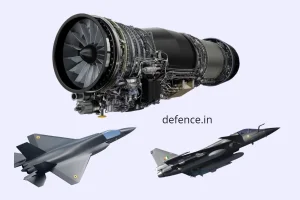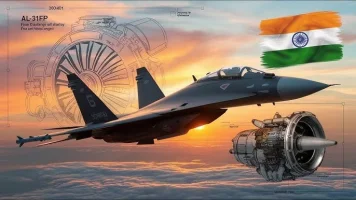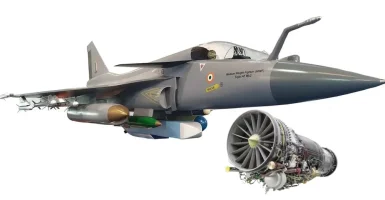- Views: 4K
- Replies: 9
A significant debate is emerging within India's strategic circles as defence analysts are advising the government to prioritise the development of an indigenous 50-ton manned stealth bomber over acquiring Russia’s formidable Tu-160M ‘White Swan’.
The core argument is that a domestically produced aircraft, evolved from the existing Ghatak stealth drone program, would provide a crucial strategic edge in modern warfare.
Such a platform, designed for covert operations deep inside enemy territory, is seen as vastly superior to the large, non-stealthy Russian bomber, which could be vulnerable to advanced air defence systems.
This proposal aligns with India's national policy of self-reliance, known as 'Aatmanirbhar Bharat', aiming to secure the nation's technological independence and military strength.
The Offer: Russia's Tu-160M 'White Swan'
Russia, a traditional defence partner, has reportedly offered India its upgraded Tupolev Tu-160M strategic bomber to enhance the Indian Air Force's (IAF) long-range strike capabilities.Known as the 'White Swan', the Tu-160M is the heaviest and fastest supersonic strategic bomber in the world, capable of flying at more than twice the speed of sound and carrying a massive payload of long-range cruise missiles.
Despite these impressive specifications, experts point to critical vulnerabilities that make it a questionable choice for India’s current geopolitical landscape.
The primary concern is the bomber's lack of stealth. With a weight approaching 200 tons, the Tu-160M possesses a very large radar cross-section (RCS), making it easily detectable by modern surveillance systems from hundreds of kilometres away.
In a potential conflict, advanced air defence networks, such as the S-400 systems operated by China, could track and intercept the bomber long before it reaches its target.
Relying on such a high-profile foreign asset also introduces risks related to supply chain disruptions and limits India's autonomy in upgrading and maintaining the fleet.
The Indigenous Vision: A Scaled-Up Ghatak Bomber
The proposed alternative stems from an existing Indian program: the Ghatak Unmanned Combat Aerial Vehicle (UCAV).Developed by the Defence Research and Development Organisation (DRDO), the 13-ton Ghatak is a stealth drone built on a 'flying-wing' design, similar to the American B-2 Spirit bomber.
This design, combined with advanced radar-absorbent materials, gives the Ghatak a very low radar profile, making it ideal for penetrating heavily defended airspace for strike and surveillance missions.
It features an internal weapons bay capable of carrying 1.5 tons of precision munitions.
The vision put forward by analysts involves scaling this proven stealth design into a 50-ton manned fighter bomber.
This new aircraft would retain the essential stealth characteristics of the Ghatak while incorporating a much larger payload and range.
Such a platform would be specifically engineered to operate covertly behind enemy lines, striking high-value targets without being easily detected—a capability the Tu-160M cannot provide.
Strategic and Technological Advantages
Developing a homegrown stealth bomber offers several key benefits for India's national security and industrial base.- Superior Survivability: The flying-wing airframe is inherently stealthy. This would allow the bomber to evade sophisticated enemy radar and air defence systems, ensuring a higher probability of mission success and safe return.
- Powerful Payload and Reach: Analysts suggest a quadjet design using four powerful 130kN engines, possibly derived from the engine being developed for India’s Advanced Medium Combat Aircraft (AMCA). This configuration would enable the bomber to carry a diverse and heavy payload, including BrahMos-NG cruise missiles, Agni-1P ballistic missiles, and laser-guided bombs over extended distances.
- Force Multiplication: The bomber could operate in coordination with unmanned Ghatak drones through a concept known as Manned-Unmanned Teaming (MUM-T). In this scenario, drones could fly ahead to scout, jam enemy radar, or engage air defences, thereby increasing the safety and effectiveness of the main manned bomber.
- Technological Self-Reliance: By building upon technologies from the Ghatak and AMCA programs, India would retain full control over the intellectual property. This fosters a domestic ecosystem for advanced aerospace manufacturing and ensures strategic independence from foreign suppliers.
Challenges and The Path Forward
Transforming this vision into reality involves overcoming significant technical and financial hurdles. The project is estimated to require an investment of at least ₹15,000 crore.A major challenge lies in developing the high-thrust jet engines required, an area where India has previously faced delays with its Kaveri engine program.
Furthermore, flying-wing aircraft lack conventional tails and rudders, demanding highly sophisticated flight control computers and software to maintain stability.
However, there is strong evidence of India's growing capability in this domain. In 2022, the DRDO successfully conducted flight trials of the Stealth Wing Flying Testbed (SWiFT), a scaled-down prototype of the Ghatak drone.
This success demonstrates that Indian engineers are mastering the complex aerodynamics and control systems associated with flying-wing designs.
The final and most critical hurdle is timely government funding. The main Ghatak UCAV program is reportedly awaiting formal clearance from the Cabinet Committee on Security (CCS), with a potential induction timeline in the late 2030s.
Experts urge the government to fast-track funding for both the unmanned drone and its proposed manned bomber derivative.
Any delay risks widening the technological gap with regional adversaries like China, which is actively developing its own fleet of stealth aircraft, including the Xian H-20 bomber and GJ-11 Sharp Sword drone.
An indigenous stealth bomber would provide India with a credible deterrent, fundamentally enhancing its ability to project power and protect its interests in a complex region.



